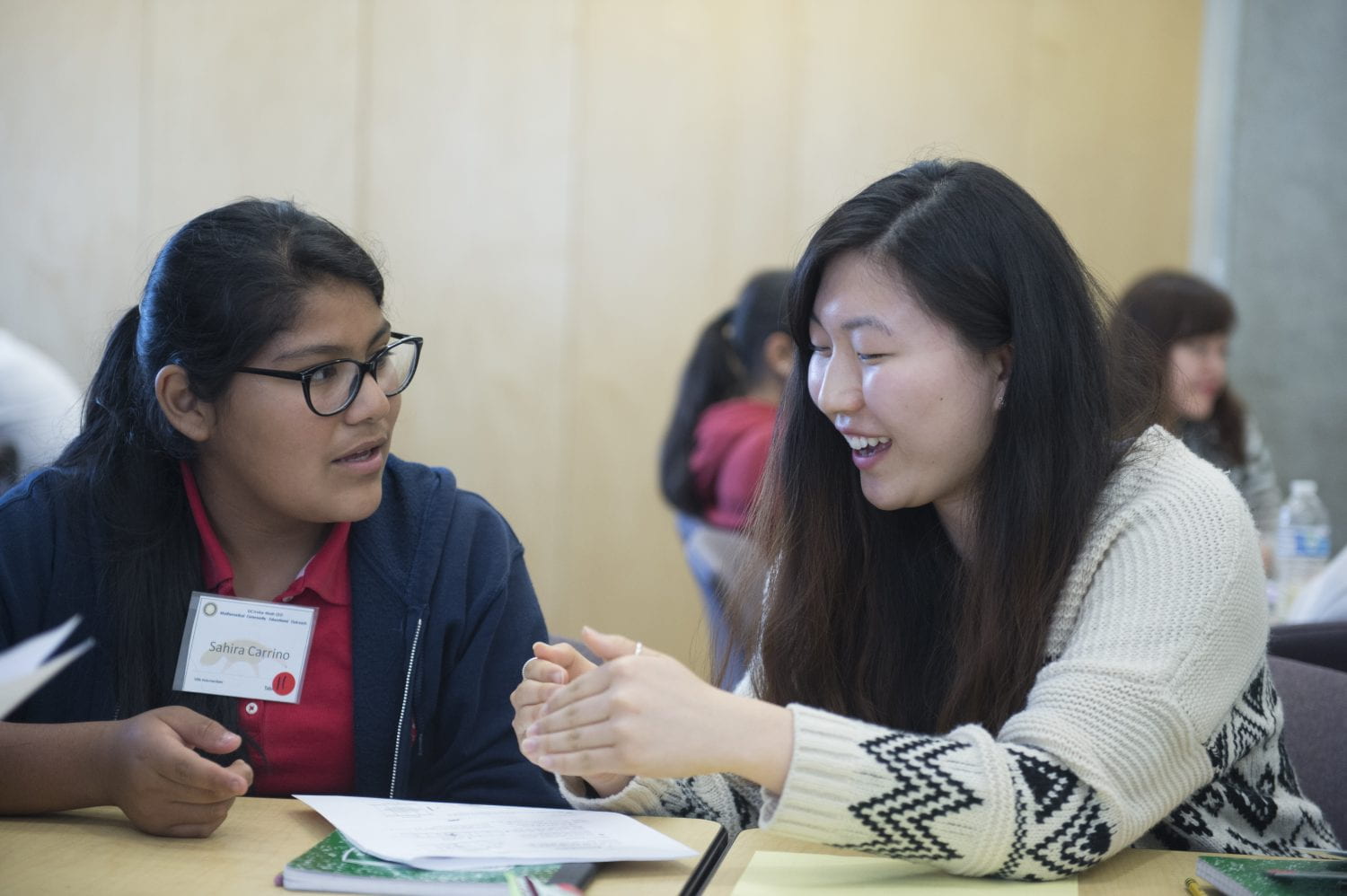Solving problems
UCI program fosters math skills and college dreams in underprivileged middle schoolers

“OK, everybody, listen up. If a community outreach program serves 25 middle school students in its first year, what is the percentage rate of growth if there are 100 participants in year two?”
It’s another Wednesday afternoon, time for more challenging word problems for sixth-, seventh- and eighth-grade students from Santa Ana. They’re bused to the University of California, Irvine for Math Community Educational Outreach, a program devised by UCI’s Department of Mathematics to help some of the most underprivileged schoolchildren in Orange County.
And the word problem reflects Math CEO’s success. It started with 25 pupils from Lathrop Intermediate School and quadrupled in size its second year with more Lathrop participants and the addition of students from the nearby Villa Fundamental Intermediate School (a growth rate of 300 percent).
“We are dealing with kids from quite a disadvantaged area,” says the program’s founding director, UCI math lecturer Alessandra Pantano. “I would say it’s 98 percent Hispanic, almost all of the kids qualify for free or reduced-cost lunches, and half have parents that didn’t finish high school.”
Math CEO began in September 2014 when Pantano and UCI associate professor of math Li-Sheng Tseng met with Jasmina Matasovic, a teacher at Lathrop, to brainstorm possible ways to help students struggling with math fundamentals.
Early on, two or three UCI faculty members and five graduate students would hold one-hour “math circles” – fun and interactive learning sessions – at the school every other Wednesday. “We would go and work with the kids when their teachers were in a staff meeting,” Pantano says.
In October 2014, Math CEO volunteers organized a field trip to UCI for Lathrop students, teachers and parents. Foreshadowing what the program would ultimately become, the time on campus revolved around learning activities for the kids and college preparation workshops for the parents.
Since then, Math CEO has expanded with the support of UCI’s physical sciences, engineering and education schools, as well as seed funding from the Samueli Foundation, the Crean Foundation and Boeing. The middle schoolers now come to campus and work in groups of five or six, each with a UCI faculty member or student.
Many of the math mentors are enrolled in a new course, Math 192, which provides teaching training and college credit for participation in Math CEO. It’s a win-win situation, because it both creates a steady stream of program staffers and gives them real-world classroom experience.
“Math CEO offers UCI students a chance to try out many different teaching methods,” Tseng notes. “It’s beneficial to them, because they get to do fieldwork right here on campus.”
Still, “most of the people involved are not doing it just for the credit,” says Cynthia Hixahuary Sanchez Tapia, Ph.D. ’16, a volunteer and coordinator with the program. “They believe in the project. I went to school in Mexico, so as a Latina, I identify with these kids. Other Math CEO participants feel the same way – that we’re doing something good for society.”
Lathrop seventh-grader Mayra Franco says her Math CEO mentor has been a role model. “She’s a true inspiration. She has proven that a Hispanic person like me can make it to college,” the middle schooler says. “She showed us that if we work extra hard, we can get a scholarship, go to college and pursue our dream jobs.”
Math CEO team members create all the materials for the program, including intricately constructed math problems and elaborately illustrated handouts and slides. A new booklet is crafted for every session.
“The illustrations, which are done by one of our volunteer’s relatives in Bogota, help make the subject matter more accessible. The math should be challenging but never scary,” Pantano says.
“We give the kids problems that are really quite tricky,” she says. “Some of them are logic-based, and many hit on things we know from their teachers that the students need the most, such as help with fractions.”
Lathrop math instructor Samantha Helstrom, a 2014 UCI graduate, confirms the academic rigor of the material. “The kids have to take time and think and work together to solve the problems,” she says. “Right now they’re working on expressions, something they’re supposed to learn in seventh grade. So this is new stuff for a bunch of sixth-graders. And it’s cool to see them understanding it already, a year early.”
According to Tseng, the math problems introduce critical thinking to the students and foster perseverance, setting the stage for success in college and stimulating interest in science, technology, engineering and math careers.
“It’s important for them to see that math is everywhere, and it’s used in all different professions,” he says. “In order for them to grab the opportunities out there, they need a very strong foundation in mathematics.”
“Some of our students in Santa Ana have never set foot on a college campus,” adds Jonathan Swanson, principal of Villa Fundamental. “So having kids here in these UCI classrooms, feeling comfortable, interacting with professors and college students, is only going to increase their own ability and desire to attend college.”